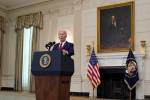EPA plan to move radiation lab out of Vegas draws protests



WASHINGTON — The Environmental Protection Agency is preparing to relocate a state-of-the-art radiation monitoring laboratory from Las Vegas to Alabama, a move that has drawn protests from nuclear safety activists and officials from Nevada and California.
EPA officials say budget tightening is behind the decision to move the Mobile Environmental Radiation Laboratory, a white paneled tractor-trailer now parked near the University of Nevada, Las Vegas and stocked with advanced radiological and chemical measuring and analytical equipment.
The agency plans to consolidate the lab-on-wheels with a sister unit in Montgomery, Ala. The plan is to keep only one laboratory in operation.
“They spent millions of dollars and a great amount of staff time to create it, and now the plan is to dismantle it,” said Dan Hirsch, president of Committee to Bridge the Gap, a California-based nuclear safety organization.
Some members of Congress and professors at UNLV say they are troubled about the move, which appears to be just the latest in a series of cutbacks to EPA resources in Southern Nevada. The EPA’s work dates to the early 1960s, when its precursor U.S. Public Health Service established a beachhead to help launch the fledgling field of radiation studies as the government was setting off atmospheric nuclear tests in the desert.
Activists and officials representing California Gov. Jerry Brown said removing the mobile lab will leave the West Coast lacking a key asset to advise emergency responders on relatively quick notice if there is a dirty bomb attack or an accident at one of nuclear power plants in the state.
Karen Beckley, radiation control manager in the administration of Gov. Brian Sandoval, said Nevada is similarly concerned.
“We are downwinders from California,” Beckley said. “If they have a power plant issue, if we have to start FedExing things to Alabama or wait for resources to come from Alabama, that significantly impacts how quickly we can respond to something.”
With the mobile lab, a companion vehicle where samples are prepared for analysis also is being relocated, along with escort command vehicles. It is not known how the relocation might affect EPA staff at the National Center for Radiation Field Operations that works out of an office building on Maryland Parkway.
“State and local governments consider these lab systems as first response assets,” Jennifer Chappelle, manager of the radiological preparedness unit in the California Governor’s Office of Emergency Services, wrote to EPA administrator Gina McCarthy in May.
In a March 24 memo, Mike Flynn, EPA director of radiation and indoor air, told colleagues of the decision to relocate the Las Vegas unit. The move has not taken place yet, the Review-Journal has learned.
Flynn in the memo said the decision to consolidate the mobile units was based on “tight resources.”
“The reality is that we have neither the staff nor the funding to maintain and operate two MERLs, “ he said using the acronym for Mobile Environmental Radiation Laboratory.
It would take four to five hours for the laboratory to be driven to Southern California in a crisis. Flynn in an interview with NBC-TV in Los Angeles said the EPA does not consider it designed to be among first on the scene of an emergency.
“Our view is that it is not part of a first response, that it comes in later,” he said in a report that aired recently. Flynn said other agencies, such as the Department of Energy, also are equipped to respond.
In a statement, the EPA said it can better support the mobile lab in Montgomery, where it operates a “strong and specialized analytical staff” at its radiochemistry laboratory.
The agency added the mobile labs are not used extensively. Over the past 15 years, neither has been deployed in an emergency, it said, adding that they have been used to help clean up only Superfund sites, one in Texas and one in Louisiana.
At the same time, the same type of analyses run by the mobile lab are available at fixed labs across the country that can run large volumes of samples “using more advanced techniques,” the EPA said.
Hirsch said Sens. Harry Reid, D-Nev., and Barbara Boxer, D-Calif., have asked EPA to explain its plan.
A spokeswoman said Reid had no comment “right now.” Boxer’s office did not respond to a query for her view.
Rep. Dina Titus, D-Nev., said she was troubled by what appears to be a pattern. She has asked McCarthy to explain a series of cutbacks to radiation-related research in Las Vegas.
“According to reports, over the past five years the National Center for Radiation Field Operations has closed its radiation analytical laboratory on the University of Nevada, Las Vegas campus, closed its radon laboratory, closed its radon canister counting program, closed its gravimetry measurement program” in addition to its intention to relocate the mobile radiation laboratory, Titus told McCarthy. “If this is accurate, and if so, what is your intention for the Las Vegas office?”
“I am committed to the EPA having a strong scientific presence in Las Vegas,” Titus added. A Titus aide said the EPA has not yet responded.
Vernon Hodge, a UNLV chemistry professor who has conducted research on radiation dispersal and has collaborated with EPA scientists, said the agency has operated a mobile radiation lab out of Las Vegas for years.
In 2000, it was dispatched to a fire burning near the Los Alamos National Laboratory in New Mexico, Hodge said. For four to five days it analyzed air samples until the fire retreated from the nuclear research lab.
The latest version was funded by the Department of Homeland Security and put in operation three years ago, but EPA officials have sought to minimize its role, he said.
Hodge said the costs are “somewhat less than $200,000” annually to keep the mobile lab maintained and certified.
“Knowing the ramifications of taking away a unit that could be very helpful in an emergency, and they are going to do it, that is criminal in my way of thinking,” Hodge said.


















